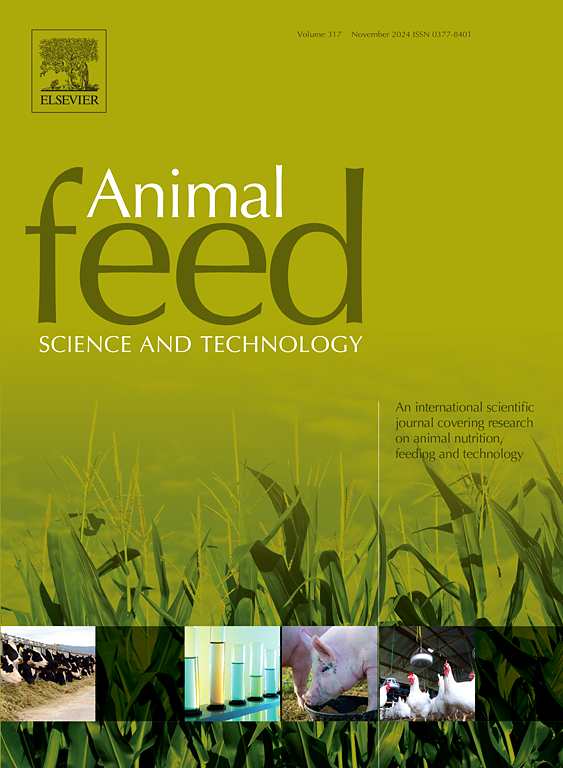瘤胃保护脂肪对瘤胃发酵产物、肉质特征、牛的生产性能和牛奶质量的影响:荟萃分析
IF 2.5
2区 农林科学
Q1 AGRICULTURE, DAIRY & ANIMAL SCIENCE
引用次数: 0
摘要
本研究旨在通过荟萃分析研究瘤胃保护脂肪(RPF)对发酵产物、肉质、牛的生产性能和牛奶质量的影响。数据库开发首先采用系统综述和荟萃分析首选报告项目(PRISMA)方法进行数据筛选。通过 Scopus 平台,共获得 30 篇研究牛 RPF 的期刊论文。然后将数据收集到一个数据库中,并将数据程序制成表格。研究数据分为未受保护脂肪(对照组)和受保护脂肪(实验组)。然后使用 OpenMEE 软件中的随机效应模型对数据进行分析。使用 RPF 能显著提高(p<0.05)牛的多项性能,如中性洗涤纤维消化率、中性洗涤纤维摄入量和胴体重。使用 RPF 还能显著降低(p<0.05)瘤胃发酵产物,如异丁酸盐含量,但能显著提高(p<0.05)异戊酸盐含量、氨氮、乙酸盐-丙酸盐比率和乙酸盐含量。在肉质特征参数方面,RPF 显著增加(p<0.05)肉的光亮度、黄度和拌料率。然而,RPF 能明显降低肉的黄度值(p<0.05)。此外,RPF 还能明显降低(p<0.05)乳蛋白含量,但能明显提高(p<0.05)产奶量。通过这项研究,可以得出结论:RPF 可以改善生长性能、瘤胃发酵产物、肉质特征和牛奶质量等多个参数。本文章由计算机程序翻译,如有差异,请以英文原文为准。
Effects of rumen-protected fat on rumen fermentation products, meat characteristics, cattle performance, and milk quality: A meta-analysis
This research aimed to investigate the influence of rumen-protected fat (RPF) on fermentation products, meat quality, cattle performance, and milk quality by conducting a meta-analysis. Database development was started with data selection using the Preferred Reporting Items for Systematic Reviews and Meta-Analyses (PRISMA) method. Through the Scopus platform, a total of 30 journal articles were obtained that investigated RPF in cattle. The data was then collected in one database, and the data procedure was tabulated. The study data were divided into unprotected fat (control group) and protected fat (experiment group). The data were then analyzed using a random effects model in OpenMEE software. The use of RPF significantly enhanced (p<0.05) several cattle performances, such as neutral detergent fiber digestibility, neutral detergent fiber intake, and carcass weight. The use of RPF also significantly decreased (p<0.05) rumen fermentation products such as isobutyrate level but significantly increased (p<0.05) isovalerate level, ammonia, acetate-propionate ratio, and acetate level. In meat characteristic parameters, RPF significantly increased (p<0.05) meat lightness, yellowness, and dressing percentage. However, RPF significantly decreased (p<0.05) the yellowness meat value. In addition, RPF has the effect of significantly reducing (p<0.05) milk protein, but significantly increasing (p<0.05) milk yield. Through this study, it was concluded that RPF can improve several parameters of growth performance, rumen fermentation products, meat characteristics, and milk quality.
求助全文
通过发布文献求助,成功后即可免费获取论文全文。
去求助
来源期刊

Animal Feed Science and Technology
农林科学-奶制品与动物科学
CiteScore
6.00
自引率
6.20%
发文量
266
审稿时长
3 months
期刊介绍:
Animal Feed Science and Technology is a unique journal publishing scientific papers of international interest focusing on animal feeds and their feeding.
Papers describing research on feed for ruminants and non-ruminants, including poultry, horses, companion animals and aquatic animals, are welcome.
The journal covers the following areas:
Nutritive value of feeds (e.g., assessment, improvement)
Methods of conserving and processing feeds that affect their nutritional value
Agronomic and climatic factors influencing the nutritive value of feeds
Utilization of feeds and the improvement of such
Metabolic, production, reproduction and health responses, as well as potential environmental impacts, of diet inputs and feed technologies (e.g., feeds, feed additives, feed components, mycotoxins)
Mathematical models relating directly to animal-feed interactions
Analytical and experimental methods for feed evaluation
Environmental impacts of feed technologies in animal production.
 求助内容:
求助内容: 应助结果提醒方式:
应助结果提醒方式:


